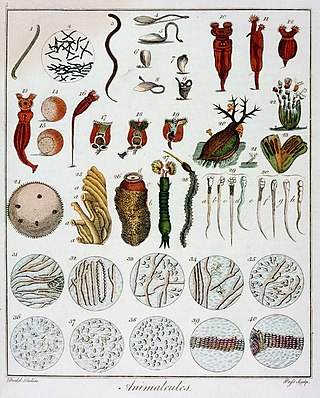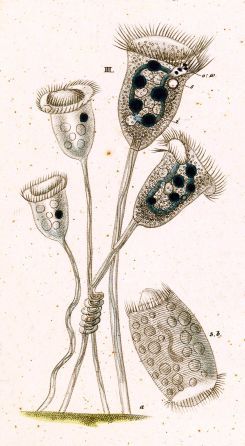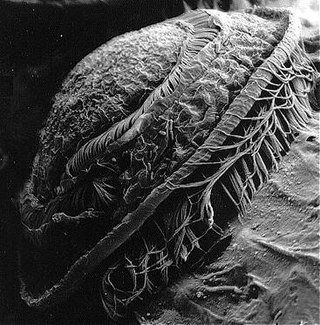
Filtration is a physical separation process that separates solid matter and fluid from a mixture using a filter medium that has a complex structure through which only the fluid can pass. Solid particles that cannot pass through the filter medium are described as oversize and the fluid that passes through is called the filtrate. Oversize particles may form a filter cake on top of the filter and may also block the filter lattice, preventing the fluid phase from crossing the filter, known as blinding. The size of the largest particles that can successfully pass through a filter is called the effective pore size of that filter. The separation of solid and fluid is imperfect; solids will be contaminated with some fluid and filtrate will contain fine particles. Filtration occurs both in nature and in engineered systems; there are biological, geological, and industrial forms.

The Oligohymenophorea are a large class of ciliates. There is typically a ventral groove containing the mouth and distinct oral cilia, separate from those of the body. These include a paroral membrane to the right of the mouth and membranelles, usually three in number, to its left. The cytopharynx is inconspicuous and never forms the complex cyrtos found in similar classes. Body cilia generally arise from monokinetids, with dikinetids occurring in limited distribution over part of the body.

The peritrichs are a large and distinctive group of ciliates.

Animalcule is an old term for microscopic organisms that included bacteria, protozoans, and very small animals. The word was invented by 17th-century Dutch scientist Antonie van Leeuwenhoek to refer to the microorganisms he observed in rainwater.
Epistylis is a genus of usually colonial peritrich ciliates with a short oral disc and collar, and a rigid stalk. The rigid stalk differentiates Epistylis from the very similar genus Carchesium in which the stalks are contractile like those in Vorticella.

Vorticella is a genus of bell-shaped ciliates that have stalks to attach themselves to substrates. The stalks have contractile myonemes, allowing them to pull the cell body against substrates. The formation of the stalk happens after the free-swimming stage.
Vorticella convallaria is a species of ciliates. It forms part of the V. convallaria species complex. V. citrina is lemon yellow to light green in colour.
A bacterivore is an organism which obtains energy and nutrients primarily or entirely from the consumption of bacteria. The term is most commonly used to describe free-living, heterotrophic, microscopic organisms such as nematodes as well as many species of amoeba and numerous other types of protozoans, but some macroscopic invertebrates are also bacterivores, including sponges, polychaetes, and certain molluscs and arthropods. Many bacterivorous organisms are adapted for generalist predation on any species of bacteria, but not all bacteria are easily digested; the spores of some species, such as Clostridium perfringens, will never be prey because of their cellular attributes.
The inverted bell is a metaphorical name for a geometric shape that resembles a bell upside-down.

Vorticella convallaria is a species of ciliates. It is the type species of the genus Vorticella. It resembles V. campanula, but differs in being somewhat narrow in the anterior end and usually having no refractile granules in the endoplasm.

Ctenophila is a genus of small air-breathing land snails, terrestrial pulmonate gastropod mollusks in the family Euconulidae, the hive snails.
Ctenophila vorticella is a species of small air-breathing land snails, terrestrial pulmonate gastropod mollusks in the family Euconulidae, the hive snails. This species is endemic to Réunion, a French island in the Indian Ocean.

Trichodina is a genus of ciliate alveolates that is ectocommensal or parasitic on aquatic animals, particularly fish. They are characterised by the presence of a ring of interlocking cytoskeletal denticles, which provide support for the cell and allow for adhesion to surfaces including fish tissue.

The protozoon Vorticella campanula is found in freshwater ponds, lakes, rivers, and streams with aquatic vegetation. It has a global distribution. Vorticella campanula is solitary and not colonial but usually social, several of them being found together. Vorticella campanula is a sedentary (fixed) form. It is commonly attached by a long highly contractile stalk to some submerged objects like weeds, animals, or stones. Vorticella campanula is often found in large groups. All the individuals in the group, however, remain free and independent of each other. Most Vorticella are found in abundance in stagnant water rich in decaying organic matter and feed largely on bacteria, but Vorticella campanula live only in uncontaminated water where bacterial growth is poor.

The ciliates are a group of alveolates characterized by the presence of hair-like organelles called cilia, which are identical in structure to eukaryotic flagella, but are in general shorter and present in much larger numbers, with a different undulating pattern than flagella. Cilia occur in all members of the group and are variously used in swimming, crawling, attachment, feeding, and sensation.
A myoneme is a contractile structure found in some eukaryotic single-celled organisms, particularly Vorticella. It consists of a series of protein filaments that shorten rapidly upon exposure to calcium. Although the shortening can be up to 100 lengths per second, faster than any muscle, the relaxation time is several seconds. The myonemes of Acantharea also display slow contraction and undulation movements.

Alexander Russell was a Scottish physician and naturalist, spending 14 years at the English factory in Aleppo.
The peritrich nuclear code is a genetic code used by the nuclear genome of the peritrich ciliates Vorticella and Opisthonecta.

Cothurnia is a genus of freshwater and marine peritrichs in the family Vaginicolidae. It is characterised by living in a transparent tubular lorica. During the feeding or vegetative phase of its life cycle, Cothurnia attaches to submerged surfaces through a short stalk — mostly on the surfaces of fishes, crustaceans and aquatic plants. It is commonly studied for its epibiotic relationship with the host that it is attached to.

Vorticellidae is a family of ciliates belonging to the order Sessilida.











